Hawaiian tribal tattoos have been around for centuries and are an essential part of Polynesian culture. These tattoos are not just skin-deep but represent a deeper connection to the history, traditions, and beliefs of the Hawaiian people. In this article with Impeccable Nest, we will explore the meanings behind Hawaiian tribal tattoos, their history, and the significance they hold in modern times.

History of Hawaiian Tribal Tattoos
The art of tattooing has been practiced in Hawaii for over 2000 years and is deeply rooted in the island’s culture. The ancient Hawaiians used tattoos as a form of spiritual expression, protecting themselves from evil spirits, and marking milestones in their lives. These tattoos were hand-tapped using sharpened boar’s teeth, bones, and other tools, making the process painful and often resulting in infections.
During the 18th century, when Western explorers arrived in Hawaii, they brought with them diseases that had a devastating effect on the native population. Along with diseases, they also brought Christianity which led to the suppression of tattooing, as it was seen as a heathen practice. For many years, Hawaiian tattoos were lost and forgotten.
In the late 20th century, there was a resurgence of interest in traditional Hawaiian tattooing. Today, Hawaiian tribal tattoos are once again gaining popularity, not just among native Hawaiians but also among people all around the world.
Symbols and Meanings in Hawaiian Tribal Tattoos
Hawaiian tribal tattoos are a distinct form of body art that have gained popularity and recognition worldwide. They are known for their striking appearance, featuring bold lines, intricate designs, and abstract shapes. These tattoos hold immense significance in Hawaiian culture and are deeply rooted in the beliefs and traditions of the indigenous people.
What sets Hawaiian tribal tattoos apart from other tattoo styles is their use of symbolism and meaning. Each design holds a unique significance and is carefully crafted to convey a particular message. For example, the shark tooth tattoo represents strength and power, while the turtle tattoo symbolizes long life and prosperity.
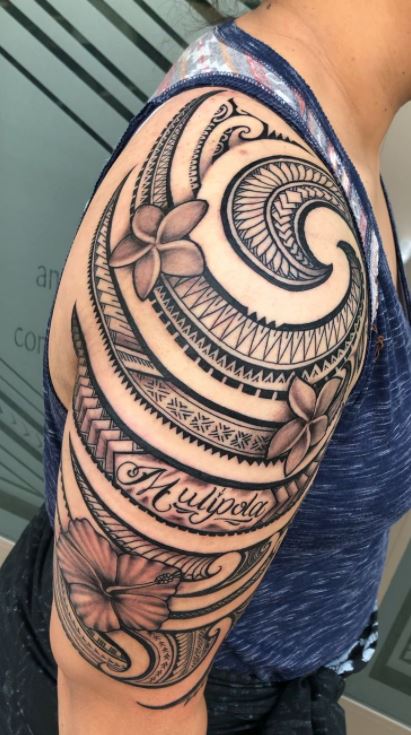
The placement of the tattoo on the body also plays a crucial role in determining its meaning. Certain designs may be reserved for specific body parts, such as the chest, arms, or legs, while others may be more versatile in their placement. The location of the tattoo can also signify a deeper meaning, such as protection, guidance, or spiritual connection.
In addition to their symbolic value, Hawaiian tribal tattoos are also renowned for their intricate designs. They often feature a mix of geometric patterns, organic shapes, and repetitive motifs, which are all carefully woven together to create a cohesive and visually stunning piece of art. Some designs may also incorporate elements of nature, such as waves, sunsets, or tropical foliage, which further enhance the beauty and uniqueness of each tattoo.
Here are some common symbols and their meanings:
Shark Teeth (Niho Mano)
Shark teeth tattoos have been considered a symbol of good luck and protection in many cultures for centuries. It is believed that the fearsome reputation of sharks and their sharp teeth can be harnessed to ward off evil spirits and protect the wearer from harm.
While the practice of wearing shark teeth as jewelry or adornment has been documented in many indigenous cultures, including those of Hawaii and New Zealand, the use of shark teeth tattoos is more recent. The design is typically applied to the lower part of the body, such as the calf or ankle, where it can easily be hidden or shown off depending on the situation.

The exact meaning or symbolism of the shark teeth tattoo may vary depending on the culture or individual interpretation. In some cases, it may represent strength, power, or ferocity, while in others it may signify protection, good luck, or even a connection with the ocean and its creatures.
In addition to its symbolic meaning, the shark teeth tattoo is also prized for its aesthetics. The jagged, triangular shape of the teeth lends itself well to bold, graphic designs that can be customized to suit the individual wearer’s preferences.
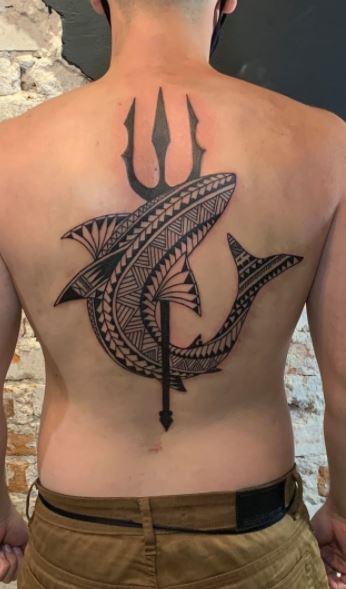
Overall, the shark teeth tattoo is a powerful and meaningful symbol that can provide a sense of connection to one’s cultural heritage, as well as a source of inspiration and strength in times of need. Whether worn as a talisman or a work of art, it remains a popular choice among tattoo enthusiasts around the world.
Sea Turtle (Honu)
The sea turtle tattoo has a rich symbolism that carries deep meaning and significance for many people. One of the main meanings behind this tattoo design is longevity, as sea turtles are known for their long lifespan, which can sometimes exceed 100 years. In this sense, the sea turtle tattoo serves as a reminder to live life to the fullest and to cherish every moment.
Another important aspect of the sea turtle tattoo is its association with good luck. Many cultures around the world believe that sea turtles bring good fortune and prosperity, and getting a sea turtle tattoo is seen as a way to attract positive energy into one’s life. This belief is deeply rooted in Hawaiian culture, where sea turtles are considered sacred animals and are believed to bring good luck to those who encounter them.
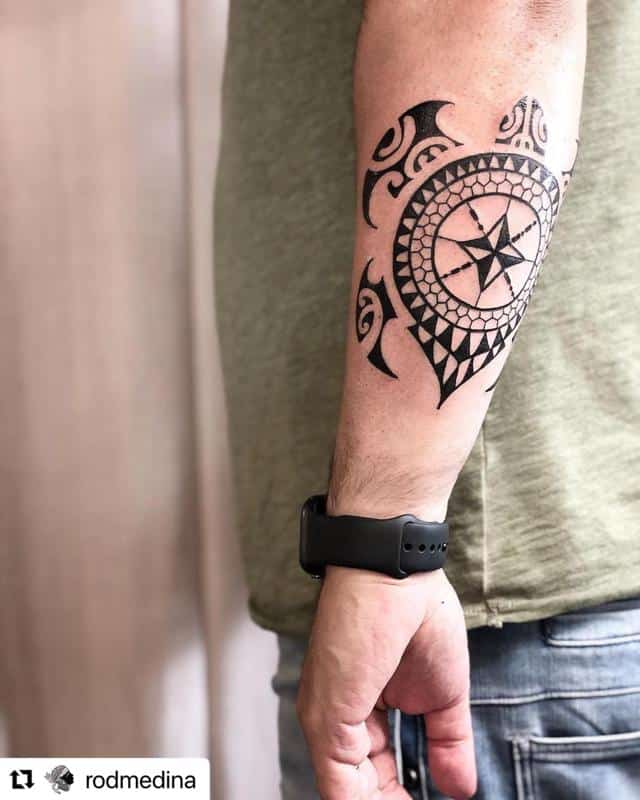
In addition to longevity and good luck, the sea turtle tattoo is also a symbol of protection. Sea turtles have a tough shell that provides them with strong defense mechanisms against predators, and this trait is often associated with the idea of protection. People who get sea turtle tattoos may do so to symbolize their own strength and resilience, or to signify their desire to protect loved ones.
Finally, the sea turtle tattoo is closely associated with the Hawaiian god of the sea, Kanaloa. In Hawaiian mythology, Kanaloa is a powerful deity who rules over the ocean and all its creatures, including sea turtles. Getting a sea turtle tattoo is therefore seen as a way to honor Kanaloa and to show respect for the natural world.
When it comes to placement, sea turtle tattoos are typically placed on the upper back or shoulder. This location allows the design to be easily seen, while also providing ample space for intricate details and shading. Some people may choose to incorporate other elements into their sea turtle tattoo designs, such as waves, coral, or other marine life.
Overall, the sea turtle tattoo is a meaningful and powerful design that carries with it a range of rich symbolism. Whether you choose to get a sea turtle tattoo as a tribute to Hawaiian culture, a symbol of strength and resilience, or simply because you love the ocean, this design is sure to make a lasting impression.
Spearheads (Makau)
Makau tattoos are a popular form of Polynesian tattooing that originated in the Hawaiian Islands. Makau, also known as fishhook tattoos, are commonly seen on the upper arm or chest of individuals who have a connection to the ocean or fishing culture.
The design of a makau tattoo typically features a fishhook shape with intricate patterns and designs incorporated within the outline. The style of the tattoo may vary depending on the individual’s preference, but traditional makau tattoos often include geometric shapes and lines, as well as symbols of nature such as waves, sharks, or turtles.
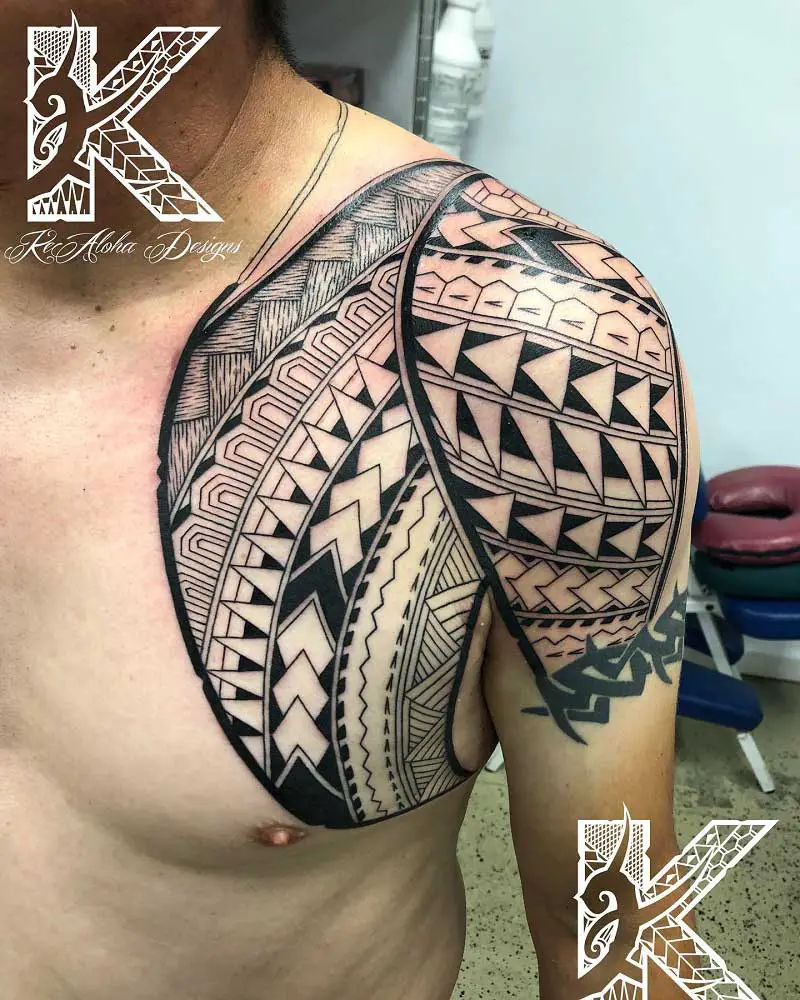
In Polynesian culture, the makau is considered a symbol of strength, prosperity, and good luck, making it a popular choice for those seeking a meaningful tattoo design. For fishermen, the makau represents their connection to the sea and their ability to provide for themselves and their families through fishing.
Additionally, the makau is believed to have spiritual significance and is sometimes used for protective purposes. It is said that wearing a makau tattoo can offer protection from harm and negative energies, particularly while engaging in activities related to the ocean.
Overall, the popularity of makau tattoos has spread beyond Polynesian culture and has become a widely recognized symbol of connection to the ocean and a love for fishing. Its beautiful and intricate design, combined with its cultural and spiritual significance, make it a meaningful and timeless tattoo choice for many.
Gecko (Mo’o)
Geckos are a popular subject of tattoos in many cultures around the world, and they often carry significant symbolic meaning. In some cultures, geckos are seen as protectors against evil spirits and are believed to bring good fortune and wealth to their owners.
One reason why geckos are associated with protection is that they are able to climb up walls and cling to surfaces with ease. This ability to “stick” to things has made geckos a symbol of resilience and adaptability, traits that are highly valued in many cultures. Additionally, geckos are known for being able to shed their tails when threatened, which can be interpreted as a sign of detachment and letting go, another trait that is often associated with personal growth and spiritual development.

In some cultures, geckos are also associated with luck and prosperity. The belief is that owning a gecko or having a gecko tattooed on the body will attract good fortune and bring wealth to the owner. This may be due in part to the fact that geckos are able to survive in a variety of environments and climates, making them a symbol of resilience and adaptability.
When it comes to tattooing, geckos are often depicted in a range of styles and designs. Some tattoos may depict geckos in a realistic style, while others may take a more stylized or abstract approach. Geckos are often tattooed on the feet or hands, which may be due in part to their association with climbing and clinging. These placements also offer a practical advantage, as they are areas of the body that are less likely to fade or distort over time.
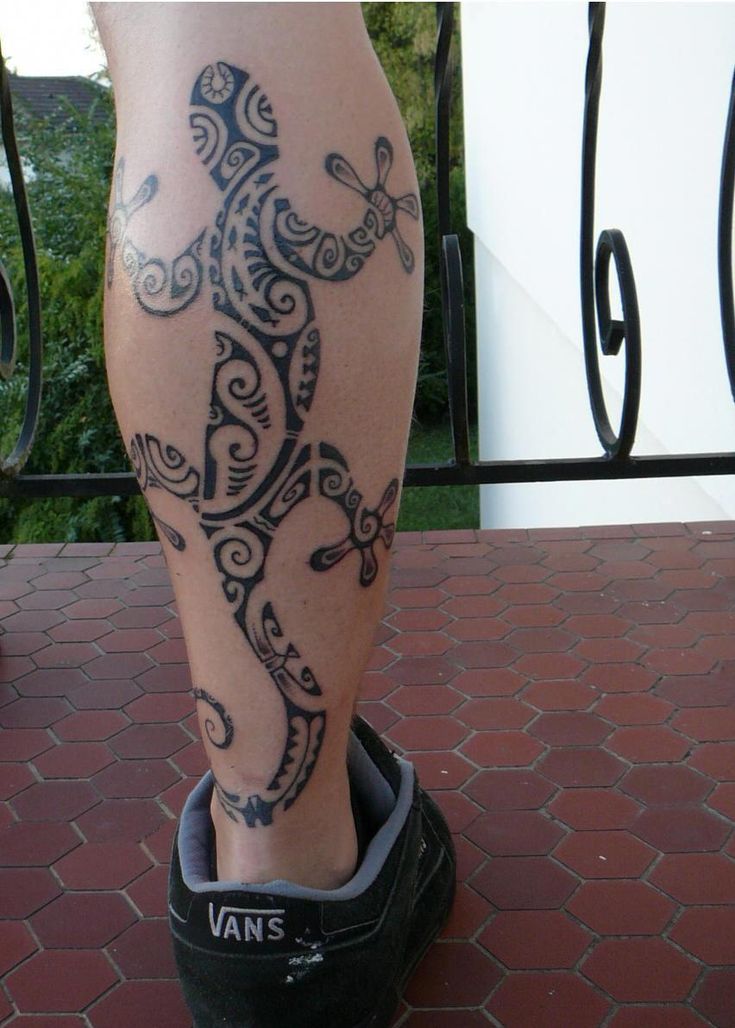
Overall, geckos are a popular subject of tattoos for a variety of reasons, including their association with protection, resilience, adaptability, and good fortune. Whether you choose to get a gecko tattoo for its symbolic meaning or simply because you think they look cool, it’s important to choose a design and placement that speaks to you personally.
Hibiscus Flower
The hibiscus flower tattoo is a popular design that carries different meanings depending on the culture and context in which it is used. The flower itself is known for its vibrant and exotic aesthetic, with its large petals and bright colors making it a symbol of beauty and glory.
For many women, the hibiscus flower tattoo represents femininity and grace, with its placement on the hips or upper thigh adding to its sensual appeal. This location is often chosen for its ability to accentuate the curves of a woman’s body, as well as for its ability to be hidden if desired.
In Hawaiian culture, the hibiscus flower has a specific significance as the state flower, representing hospitality, friendship, and love. It is often given as a gift to visitors or used in traditional lei garlands, symbolizing the spirit of aloha and welcoming.
In other cultures, the hibiscus flower tattoo may hold different meanings. In some Asian countries, the hibiscus is associated with delicate beauty and elegance, while in African countries it may represent royalty and power.
Regardless of its cultural associations, the hibiscus flower tattoo remains a popular choice among women for its striking appearance and symbolic meaning. Whether worn for its aesthetic value or as a personal statement, this tattoo design holds a special place in the world of body art.
Sun (La)
The sun is a powerful symbol that has been revered in various cultures for thousands of years. In the context of tattoos, the sun design has become incredibly popular due to its association with warmth, light, and life. The tattoo represents an optimistic outlook on life and can be interpreted in many different ways depending on the individual’s personal values and beliefs.
One of the most significant meanings associated with the sun tattoo is warmth. The sun provides heat and energy to the planet, allowing life to thrive. As such, the sun tattoo can represent the warmth of love and friendship, as well as the comfort and security found in the presence of those we care about. The sun tattoo can also symbolize the warmth of a new beginning or the hope of a brighter future.

Another important meaning associated with the sun tattoo is light. The sun is often seen as a source of enlightenment, illuminating the darkness and providing direction. As a tattoo design, the sun can represent knowledge and wisdom, as well as spiritual awakening and growth. It can also symbolize guidance and protection, acting as a beacon of hope during times of uncertainty.
Finally, the sun tattoo represents life itself. The sun is essential for the survival of all living things, and without it, our world would be dark and barren. As such, the sun tattoo can be seen as a celebration of life and vitality. It can represent the joy and beauty of existence and remind us to make the most of every moment.
Overall, the sun tattoo is a versatile and meaningful design that can carry many different interpretations. It can be found in various sizes and placements, from small designs on the wrist or ankle to larger pieces covering the back or chest. Whether chosen for its warmth, light, or life-affirming qualities, the sun tattoo remains a popular and powerful symbol in the world of body art.
Modern Interpretations of Hawaiian Tribal Tattoos
In modern times, Hawaiian tribal tattoos have evolved into a global phenomenon, with people around the world getting inked with Polynesian-inspired designs. While some people still choose traditional designs with deep cultural and spiritual meanings, others opt for more modern interpretations.
Some tattoo artists incorporate elements of other cultures, such as Japanese or Maori designs, into their Hawaiian tribal tattoos. Others use contemporary styles, like watercolor or 3D designs, to create unique and personalized tattoos.
Conclusion
Hawaiian tribal tattoos have a rich history and are deeply rooted in Polynesian culture. Every design holds a unique meaning and symbolizes different aspects of life, from protection and strength to beauty and good fortune. Today, Hawaiian tribal tattoos have evolved into a global phenomenon, with people all around the world getting inked with Polynesian-inspired designs.
Read more:
What Polynesian Tribal Tattoo Meanings Tell Us About Their Culture – A Comprehensive Guide

I am Harvey Berry, a tattoo enthusiast who has immersed himself in the diverse world of ink, passionately exploring the beauty and artistry within each tattoo. My mission extends beyond uncovering the aesthetics of tattooing; it involves sharing in-depth knowledge across all aspects of this art form.
Fueled by genuine curiosity and love for every facet of tattooing, I have diligently crafted well-researched articles, with a special focus on the Tattoo Meaning of Impeccable Nest section. Here, my aim is to help the tattoo community gain a deeper understanding of the meanings and values embedded in each tattoo.
One of my primary goals is to encourage responsible decision-making when it comes to getting inked. I recognize that choosing to get a tattoo is a significant personal decision that requires careful consideration. Hence, I provide diverse resources covering the meaning of tattoos, the tattooing process, aftercare tips, and other valuable information.
Whether you are a seasoned tattoo enthusiast or embarking on your first exploration of the world of body art, I aspire to be a reliable resource for you at every step of your journey. I hope that my extensive knowledge of tattoos, especially in the Tattoo Meaning section, will assist you in finding inspiration to express yourself through the art of tattoos.
